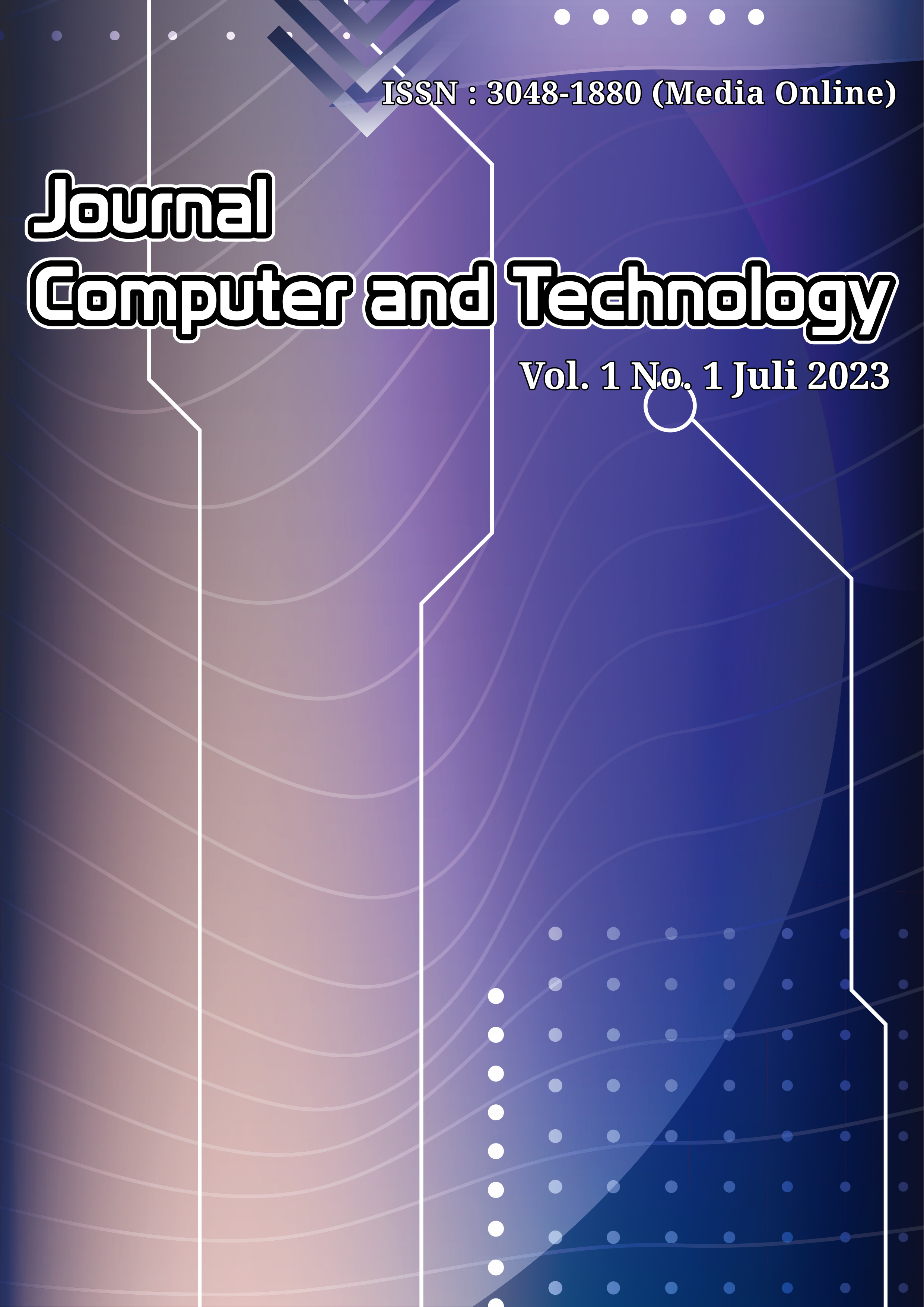FAKE REVIEW DETECTION ON DIGITAL PLATFORMS USING THE ROBERTA MODEL: A DEEP LEARNING AND NLP APPROACH
DOI:
https://doi.org/10.69916/comtechno.v3i1.355Keywords:
Fake Reviews, roBERTa, NLP, Deep Learning, Classification TextAbstract
Fake reviews have emerged as a serious threat to the integrity of digital platforms, particularly in e-commerce and online review sites. This study explores the application of RoBERTa (Robustly Optimized BERT Approach), a transformer-based architecture optimized for natural language processing (NLP), in automatically detecting fake reviews. The methodology includes data collection from online platforms, contextual feature extraction using RoBERTa embeddings, model training through supervised learning, and evaluation using classification metrics such as accuracy, precision, recall, and F1-score. The training results indicate a significant convergence trend in the training loss, while the validation loss remains relatively unstable, reflecting challenges in model generalization. Nevertheless, experimental results demonstrate that RoBERTa outperforms other approaches such as Logistic Regression PU, K-NN with EM, and LDA-BPTextCNN, achieving an accuracy of 86.25%. These findings highlight RoBERTa's strong potential in detecting manipulative content and underscore its value as an essential tool in building a transparent and trustworthy digital ecosystem.
References
D. I. Adelani, H. Mai, F. Fang, H. H. Nguyen, J. Yamagishi, and I. Echizen, “Generating Sentiment-Preserving Fake Online Reviews Using Neural Language Models and Their Human- and Machine-based Detection,” Jul. 2019, [Online]. Available: http://arxiv.org/abs/1907.09177
R. Mohawesh, S. Xu, M. Springer, M. Al-Hawawreh, and S. Maqsood, “Fake or Genuine? Contextualised Text Representation for Fake Review Detection,” Academy and Industry Research Collaboration Center (AIRCC), Dec. 2021, pp. 137–148. doi: 10.5121/csit.2021.112311.
A. Melleng, A. J. Loughrey, and P. Deepak, “Sentiment and emotion based text representation for fake reviews detection,” in International Conference Recent Advances in Natural Language Processing, RANLP, Incoma Ltd, 2019, pp. 750–757. doi: 10.26615/978-954-452-056-4_087.
A. P. Rifai et al., “DETECTION MODEL FOR FAKE NEWS ON COVID-19 IN INDONESIA,” ASEAN Engineering Journal, vol. 13, no. 4, pp. 119–126, 2023, doi: 10.11113/aej.V13.19648.
N. A. Semary, W. Ahmed, K. Amin, P. Pławiak, and M. Hammad, “Improving sentiment classification using a RoBERTa-based hybrid model,” Front Hum Neurosci, vol. 17, Dec. 2023, doi: 10.3389/fnhum.2023.1292010.
Maysara Mazin Badr Alsaad, “Transformer-Based Language Deep Learning Detection of Fake Reviews on Online Products,” Journal of Electrical Systems, vol. 20, no. 3, pp. 2368–2378, May 2024, doi: 10.52783/jes.4083.
M. Puttarattanamanee, L. Boongasame, and K. Thammarak, “A Comparative Study of Sentiment Analysis Methods for Detecting Fake Reviews in E-Commerce,” HighTech and Innovation Journal, vol. 4, no. 2, pp. 349–363, Jun. 2023, doi: 10.28991/HIJ-2023-04-02-08.
S. Kanmani and S. Balasubramanian, “Leveraging Readability and Sentiment in Spam Review Filtering Using Transformer Models,” Computer Systems Science and Engineering, vol. 45, no. 2, pp. 1439–1454, 2023, doi: 10.32604/csse.2023.029953.
T. Sajid et al., “Analysis and Challenges in Detecting the Fake Reviews of Products using Naïve Bayes and Random Forest Techniques,” Jun. 23, 2023. doi: 10.21203/rs.3.rs-2302761/v1.
M. A. Al-Garadi et al., “Predicting Cyberbullying on Social Media in the Big Data Era Using Machine Learning Algorithms: Review of Literature and Open Challenges,” IEEE Access, vol. 7, pp. 70701–70718, 2019, doi: 10.1109/ACCESS.2019.2918354.
S. Hu, A. Kumar, F. Al-Turjman, S. Gupta, S. Seth, and Shubham, “Reviewer Credibility and Sentiment Analysis Based User Profile Modelling for Online Product Recommendation,” IEEE Access, vol. 8, pp. 26172–26189, 2020, doi: 10.1109/ACCESS.2020.2971087.
Y. Wu, E. W. T. Ngai, P. Wu, and C. Wu, “Fake online reviews: Literature review, synthesis, and directions for future research,” Decis Support Syst, vol. 132, May 2020, doi: 10.1016/j.dss.2020.113280.
P. Gupta, “Leveraging Transfer learning techniques-BERT, RoBERTa, ALBERT and DistilBERT for Fake Review Detection MSc Research Project Data Analytics.”
M. Ott, C. Cardie, and J. T. Hancock, “Negative Deceptive Opinion Spam,” Association for Computational Linguistics, 2013. [Online]. Available: http://plagiarisma.net
J. K. Rout, A. Dalmia, K.-K. R. Choo, S. Bakshi, and S. K. Jena, “Revisiting Semi-Supervised Learning for Online Deceptive Review Detection,” IEEE Access, vol. 5, pp. 1319–1327, 2017, doi: 10.1109/ACCESS.2017.2655032.
N. Mkwananzi and H. Smuts, “Guidelines for Detecting Cyberbullying in Social Media Data Through Text Analysis,” International Journal of Social Media and Online Communities, vol. 15, no. 1, pp. 1–13, Sep. 2023, doi: 10.4018/IJSMOC.330533.
C. P. Barlett, C. Bennardi, S. Williams, and T. Zlupko, “Theoretically Predicting Cyberbullying Perpetration in Youth With the BGCM: Unique Challenges and Promising Research Opportunities,” Front Psychol, vol. 12, Sep. 2021, doi: 10.3389/fpsyg.2021.708277.
N. Cao, S. Ji, D. K. W. Chiu, M. He, and X. Sun, “A deceptive review detection framework: Combination of coarse and fine-grained features,” Expert Syst Appl, vol. 156, Oct. 2020, doi: 10.1016/j.eswa.2020.113465.
Downloads
Published
Scite Metrics
Altmetric
How to Cite
Issue
Section
License
Copyright (c) 2025 Zulpan Hadi, Lalu Moh. Nurkholis, Bahtiar Imran, Selamet Riadi, Emi Suryadi

This work is licensed under a Creative Commons Attribution 4.0 International License.
Most read articles by the same author(s)
- Zaenul Mutaqin, Bahtiar Imran, Sri Rosida, SISTEM INFORMASI PENJUALAN ONLINE (E-COMMERCE) BERBASIS WEB PADA TOKO MATAHARI PRAYA , Journal Computer and Technology: Vol. 1 No. 2 (2023): Desember 2023
- Zulpan Hadi, Emi Suryadi, Ardiyallah Akbar, Zaenudin, Rudi Muslim, CYBER BULLYING SENTIMENT ANALYSIS BASED ON SOCIAL CATEGORIES USING THE CHI-SQUARE TEST , Journal Computer and Technology: Vol. 2 No. 1 (2024): Juli 2024
- Lutfi Hamim, Bahtiar Imran, Ardiyallah Akbar, SISTEM PAKAR DIAGNOSIS PENYAKIT PADA TANAMAN KACANG HIJAU BERBASIS WEB MENGGUNAKAN METODE DEMPSTER SHAFER , Journal Computer and Technology: Vol. 1 No. 1 (2023): Juli 2023
- Elin Febriani Febri, Bahtiar Imran, Rudi Muslim, SISTEM INFORMASI E-COMMERCE PENJUALAN KERAJINAN ROTAN BERBASIS WEBSITE PADA DESA LOANG MAKA KECAMATAN JANAPRIA , Journal Computer and Technology: Vol. 1 No. 1 (2023): Juli 2023
- Muh Hamzah Andung Giardi, Bahtiar Imran, Emi Suryadi, SISTEM PAKAR DIAGNOSA PENYAKIT MANDUL PADA PRIA MENGGUNAKAN METODE CERTAINTY FACTOR BERBASIS WEBSITE , Journal Computer and Technology: Vol. 1 No. 1 (2023): Juli 2023
- Athaur Muttaqin, Muhammad Multazam, Bahtiar Imran, SISTEM PAKAR DIAGNOSIS PENYAKIT BAWANG MERAH BERBASIS WEB MENGGUNAKAN METODE FORWARD CHAINING , Journal Computer and Technology: Vol. 2 No. 2 (2024): Desember 2024











